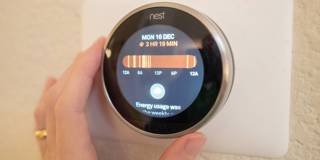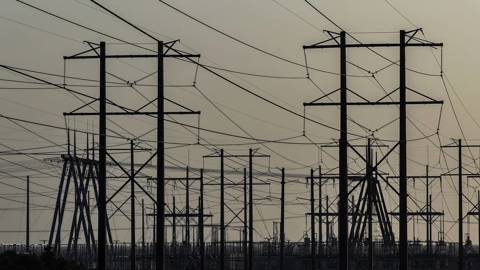Just as the world needs better access to medical care, it also needs more efficient and reliable power, and Big Tech companies, motivated by self-interest, are pouring resources into the sector. For traditional utilities, the best response is to work with these free-wheeling, free-spending technical wizards to boost efficiency.
SAN DIEGO – If John D. Rockefeller were around today, he’d be screwing a Google Nest – the pioneering smart thermostat – into the wall of his home. The notoriously thrifty oil baron would have jumped at the chance to save on his monthly energy bill.
Traditional energy companies, from ExxonMobil (the direct descendent of Rockefeller’s Standard Oil Company) to local utilities, have begun to embrace Big Tech, brimming with both hope and trepidation. Will companies like Google, Amazon, and Meta put the meter reader and his bosses out to pasture? Who wins if they do?
Big Tech has already shown a propensity to disrupt. Just 25 years ago, a “googol” – the inspiration for the search engine’s name – was an unfathomably large number, a cloud was a billowing puff in the sky, and 5G was the row in which you parked your car at the garage. In the intervening decades, tech companies have upended industries both at the enterprise and retail levels.
Consider pharmacies, which relied on the patience of shoppers to wait days for a prescription and stand in queues to retrieve them. Now companies like Hims & Hers will confidentially overnight drugs to calm your nerves, grow your hair, or put you in the mood. Meanwhile, One Medical, which Amazon purchased last year, offers 24-hour on-demand virtual care and same- and next-day appointments – quite a feat considering the average wait time to see a physician in major American cities is more than three weeks. No wonder the profit margins of brick-and-mortar drugstores have fallen, plunging Rite-Aid into bankruptcy.
Just as the world needs better access to medical care, it also needs more efficient and reliable power. Too many people are sitting in the dark too often, and for too long. Even in developed countries like the United States, the average duration of a blackout doubled between 2013 and 2021, from 3.5 hours to more than seven hours, while their frequency jumped by nearly 20%. Not surprisingly, Americans are taking a dimmer view of their local utilities, with 71% saying they would switch providers, while businesses complain that power outages cost them $150 billion per year.
That doesn’t mean utilities deserve all the blame. In the US, local and state politicians and regulators dictate profits and prices, while delaying capital upgrades. The US Department of Energy spends around five years assessing a new project before approval, leaving roughly 2,000 gigawatts of annual capacity waiting in the queue.
Fast-growing trillion-dollar tech companies cannot afford to lose power, so they are taking matters into their own hands. Amazon’s clean-energy portfolio, which comprises solar and wind projects in more than 20 US states and 27 countries, is now big enough to power 7.2 million American homes each year. In Nevada’s Blue Mountain geothermal field, Google is partnering with clean-energy start-up Fervo to power the tech behemoth’s data centers by tapping the heat trapped below Jurassic rocks.
Unlike a utility saddled with old plants that need to be decommissioned, tech companies can start anew. The average age of an oil-burning steam-turbine plant in the Midwest is pushing 70 years. In fact, Whiting, Wisconsin, runs a hydropower facility built in 1891 – 40 years before actor Boris Karloff was hooked up to lightning-conducting electrodes in the original Frankenstein.
Although self-interest motivated tech companies to create new power supplies, they have their sights set on residential consumers. Fortunately, Big Tech is already welcome in the home. Amazon evolved from delivering brown boxes of books to answering questions with Alexa and recording doorbell activity with Ring cameras.
Google recently merged Nest Renew, its service to help users optimize their electricity usage, with the software business OhmConnect to align the energy consumption of households across the country. The new company, Renew Home, will pay people to lower their thermostats and turn off their lights during peak hours or even, when combined with artificial intelligence-enabled weather forecasting, before lightning storms strike.
Executives at traditional electric utilities should respond to these free-wheeling, free-spending technical wizards by rewatching The Godfather, Part II, and heeding mob boss Michael Corleone’s advice: “keep your friends close, but your enemies closer.” At the same time, they should focus on communicating better with their customers. Has your utility ever sent you a newsletter, a movie link, or a dozen roses? Or does it come to mind only when you have a complaint, whether about the lights going off or a meter reader skulking in the backyard?
Lastly, utilities should work with Big Tech to boost efficiency. A few weeks ago, Southern Company announced a deal with Samsung SmartThings to create an innovation laboratory aimed at prodding communication among smart refrigerators, dishwashers, and garage-door openers in an effort to save power. In San Diego, the utility company Sempra is partnering with Fermata Energy so that electric vehicles can sell their battery power back to the grid when demand peaks.
Ever since the age of Rockefeller and Thomas Edison, utilities were the Steady Eddies of investments, the clichéd favorite of dividend-seeking widows and other risk-averse investors. Whether or not the climate is getting warmer, the sector is getting hotter. And as Big Tech enters, sparks are beginning to fly.











SAN DIEGO – If John D. Rockefeller were around today, he’d be screwing a Google Nest – the pioneering smart thermostat – into the wall of his home. The notoriously thrifty oil baron would have jumped at the chance to save on his monthly energy bill.
Traditional energy companies, from ExxonMobil (the direct descendent of Rockefeller’s Standard Oil Company) to local utilities, have begun to embrace Big Tech, brimming with both hope and trepidation. Will companies like Google, Amazon, and Meta put the meter reader and his bosses out to pasture? Who wins if they do?
Big Tech has already shown a propensity to disrupt. Just 25 years ago, a “googol” – the inspiration for the search engine’s name – was an unfathomably large number, a cloud was a billowing puff in the sky, and 5G was the row in which you parked your car at the garage. In the intervening decades, tech companies have upended industries both at the enterprise and retail levels.
Consider pharmacies, which relied on the patience of shoppers to wait days for a prescription and stand in queues to retrieve them. Now companies like Hims & Hers will confidentially overnight drugs to calm your nerves, grow your hair, or put you in the mood. Meanwhile, One Medical, which Amazon purchased last year, offers 24-hour on-demand virtual care and same- and next-day appointments – quite a feat considering the average wait time to see a physician in major American cities is more than three weeks. No wonder the profit margins of brick-and-mortar drugstores have fallen, plunging Rite-Aid into bankruptcy.
Just as the world needs better access to medical care, it also needs more efficient and reliable power. Too many people are sitting in the dark too often, and for too long. Even in developed countries like the United States, the average duration of a blackout doubled between 2013 and 2021, from 3.5 hours to more than seven hours, while their frequency jumped by nearly 20%. Not surprisingly, Americans are taking a dimmer view of their local utilities, with 71% saying they would switch providers, while businesses complain that power outages cost them $150 billion per year.
That doesn’t mean utilities deserve all the blame. In the US, local and state politicians and regulators dictate profits and prices, while delaying capital upgrades. The US Department of Energy spends around five years assessing a new project before approval, leaving roughly 2,000 gigawatts of annual capacity waiting in the queue.
SPRING SALE: Save 40% on all new Digital or Digital Plus subscriptions
Subscribe now to gain greater access to Project Syndicate – including every commentary and our entire On Point suite of subscriber-exclusive content – starting at just $49.99.
Subscribe Now
Fast-growing trillion-dollar tech companies cannot afford to lose power, so they are taking matters into their own hands. Amazon’s clean-energy portfolio, which comprises solar and wind projects in more than 20 US states and 27 countries, is now big enough to power 7.2 million American homes each year. In Nevada’s Blue Mountain geothermal field, Google is partnering with clean-energy start-up Fervo to power the tech behemoth’s data centers by tapping the heat trapped below Jurassic rocks.
Unlike a utility saddled with old plants that need to be decommissioned, tech companies can start anew. The average age of an oil-burning steam-turbine plant in the Midwest is pushing 70 years. In fact, Whiting, Wisconsin, runs a hydropower facility built in 1891 – 40 years before actor Boris Karloff was hooked up to lightning-conducting electrodes in the original Frankenstein.
Although self-interest motivated tech companies to create new power supplies, they have their sights set on residential consumers. Fortunately, Big Tech is already welcome in the home. Amazon evolved from delivering brown boxes of books to answering questions with Alexa and recording doorbell activity with Ring cameras.
Google recently merged Nest Renew, its service to help users optimize their electricity usage, with the software business OhmConnect to align the energy consumption of households across the country. The new company, Renew Home, will pay people to lower their thermostats and turn off their lights during peak hours or even, when combined with artificial intelligence-enabled weather forecasting, before lightning storms strike.
Executives at traditional electric utilities should respond to these free-wheeling, free-spending technical wizards by rewatching The Godfather, Part II, and heeding mob boss Michael Corleone’s advice: “keep your friends close, but your enemies closer.” At the same time, they should focus on communicating better with their customers. Has your utility ever sent you a newsletter, a movie link, or a dozen roses? Or does it come to mind only when you have a complaint, whether about the lights going off or a meter reader skulking in the backyard?
Lastly, utilities should work with Big Tech to boost efficiency. A few weeks ago, Southern Company announced a deal with Samsung SmartThings to create an innovation laboratory aimed at prodding communication among smart refrigerators, dishwashers, and garage-door openers in an effort to save power. In San Diego, the utility company Sempra is partnering with Fermata Energy so that electric vehicles can sell their battery power back to the grid when demand peaks.
Ever since the age of Rockefeller and Thomas Edison, utilities were the Steady Eddies of investments, the clichéd favorite of dividend-seeking widows and other risk-averse investors. Whether or not the climate is getting warmer, the sector is getting hotter. And as Big Tech enters, sparks are beginning to fly.